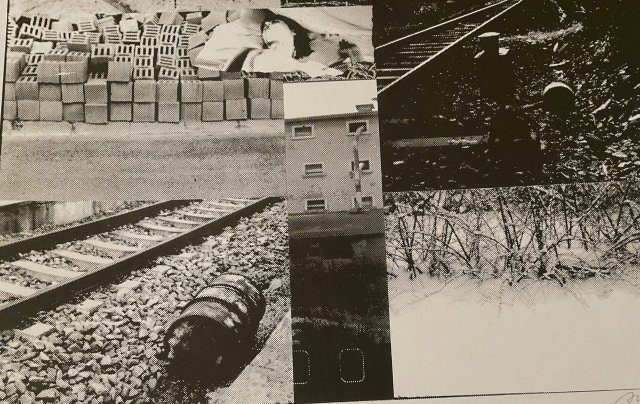Art, rhythmically structured: “Good Night” from Ingo Arnold’s cycle “Winterreise”, 1984
Photo: Gerhard Müller archive
A small artist colony once often met in Müggelheim, just outside Berlin. They were united by no program, but by neighborly friendship and a tireless spirit of mockery. In the 70s and 80s we often met at the composer Reiner Bredemeyer or across the street at the graphic artist Ingo Arnold: the composers Friedrich Goldmann, Georg Katzer, Siegfried Matthus, Friedrich Schenker, the flautist Werner Tast and the oboer Burkhard Glaetzner, the musicologists Frank Schneider and Mathias Hansen, and sometimes the writers Volker Braun, Heiner Müller, Karl Mickel, Friedrich Dieckmann and others. Reiner showed his notes, Ingo his graphics. Not everything could be demonstrated. For example, Bredemeyer’s “Newspaper Symphony” from “ND” quotes, which was speechless and toneless because the execution instructions were: “To play one centimeter above the strings.”
The official government portraits hung in Ingo Arnold’s apartment across the street, like in a school or office: Sindermann, Honecker, Stoph. They were cut into vertical segments with scissors, zebra stripes turned them into monumental carnival grotesques that greeted everyone with cut-up smiles. They were not hanging in the living room, but in the basement. The images were mysteriously enigmatic, they predicted the crash, which promptly happened.
A metronome ticks in Ingo Arnold’s works, they are rhythmically structured and sometimes intersected by vertical lines like bar lines in a musical score. We see a fragmented world. It leads to an “evening world” where “trumpet noise” sounds and the daily “cold front report” announces the new “ice world order”. These word monsters are the titles of his “Four Serious Leaves”. “Four Ernste Gesänge” is the name of Johannes Brahms’ last composition. But it is not Brahms who is invoked, but a poet – the romantic Wilhelm Müller. These photo collages are related to his poem cycle “Winterreise”. With the poems, not with Franz Schubert’s melodies. The poet Karl Mickel commented on it with his variant of Karl Marx’s eleventh Feuerbach thesis: “The world has been changed. It’s now a matter of interpreting them again.”
In Müggelheim the linden trees were blooming, the waves of the Große Krampe were splashing. Our conversations were disorganized, torn by violent laughter, more polemical than principled. At the end of these evenings, each of us could have said with Johannes Brahms: “If I forgot to offend anyone today, I ask for your forgiveness.” The new “Winterreise” was also born in this milieu. One day Reiner Bredemeyer came to the Komische Oper and brought a bundle of sheet music: “Winterreise – 24 Lieder nach Wilhelm Müller” was written on it. “You’re crazy,” I said. “You have no chance against Schubert.” “Ingo Arnold is also doing a cycle of photographic collages,” he replied.
In 1984, Arnold created a cycle of twelve calendar sheets, and one of these sheets hung on the wall above the work table. You can see a bookcase and in front of it a cemetery with snow-covered gravestones. So Bredemeyer saw this picture and shouted: “This is my winter journey.” Ingo Arnold didn’t know anything about it at the time; it had just been composed and not yet performed. That didn’t happen until a year later at the Komische Oper, and the new “Winterreise” was, contrary to all predictions, a great success. But Arnold created 24 new photo collages in the style of his cemetery library, a sheet for each of Müller’s 24 poems, and each signed with two lines of verse.
Ingo Arnold has translated these new songs to the old texts into modern photo montages that no longer recognize Napoleon or Hohenzollern. The photo collages show frozen trees, meadows, paths, bridges or fences in the snow, tracks that lead nowhere, signs in the void, a crow on a screen. But how they are put together is the sharp point that hits the heart.
Ingo Arnold, born in 1931, lived in Berlin-Köpenick all his life – in Müggelheim for 60 years and in the old town since 1987. He lost his father in the war and his mother died early. He witnessed with horror how a British pilot who had been shot down was driven through the village while being insulted and spit on by one of his teachers. The experience gave him – as well as his later friend Bredemeyer – a lifelong hatred of everything military. In 1970 he acquired a graphics diploma externally from Wolfgang Mattheuer. He was a lecturer in image and book design for nine years. The last letter he sent me came last January: “Stop and look / the roots / and the moss, the iron / and the rust, the water / and the stone, the light / and its star.”
Ingo Arnold’s cosmos does not know the romantic green and hopeful rustling of spring. When Eterna, the GDR’s classical music label, commissioned him to design the cover for a complete edition of Beethoven, he chose motifs by Michelangelo. That was his answer: Beethoven not as a classic, but as a rebel. The 24 sheets of “Winterreise” are among the most important graphic works of the GDR. Ingo Arnold died on December 9th.
Become a member of the nd.Genossenschaft!

Since January 1, 2022, the »nd« will be published as an independent left-wing newspaper owned by the staff and readers. Be there and support media diversity and visible left-wing positions as a cooperative member. Fill out the membership form now.
More information on www.dasnd.de/genossenschaft
sbobet88 judi bola online link slot demo judi bola online
